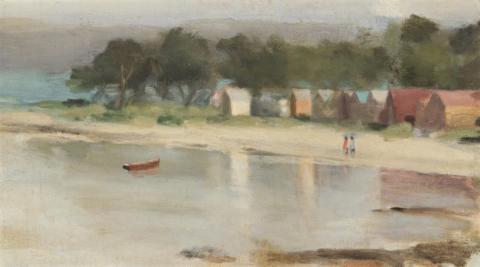TI-TREE AT EVENING (BEAUMARIS), c.1932
CLARICE BECKETT
oil on canvas on board
28.5 x 50.5 cm
inscribed verso: 41
Private collection, Melbourne
Private collection, Melbourne
Memorial Exhibition, Clarice Beckett, Athenaeum, Melbourne, 4–16 May 1936, cat. 41 (as 'Ti-Tree at Evening')
Boatsheds and bathing boxes were strung along the beaches of Port Phillip Bay for the shelter of the boats as well as the bodies of the affluent. As motifs they had been associated with Beckett's work since 1920.'1
'From the beginning Beckett was irresistibly drawn to the sea, painting the beaches around Port Phillip Bay, although the Mornington Peninsula also featured in her work. Beaumaris Beach, Ricketts Point, Watkins Bay, Half Moon Bay, Black Rock, Sandringham and Brighton were those most mined for inspiration, being areas accessible by foot. Water in all its shifting patterns and fluid rhythms is a difficult challenge to any artist but Beckett handled the painting of ponds and rivers, of still and stormy seas, with equal skill.'2
'In common with all 'Meldrum' tonalist paintings, Beckett's were not meant for close inspection. Ideally, the viewer was meant to be from six to eight paces back from the canvas, this distanced viewing being essential to bring the image into a cohesive, highly atmospheric 'illusion' of reality. Early in her career, she reached a high degree of technical prowess, due to her dedicated analytical observation of light and its effects upon form. This gave her a mastery and an understanding of the most delicate of tonal nuances. With the use of very little paint confidently placed she swiftly turned the most insignificant of impressions into monumental visions.'3
1. Hollinrake, R., Clarice Beckett: Politically Incorrect, 1999, The Ian Potter Museum of Art, Melbourne, p. 27
2. Ibid., p. 26
3. Ibid., p. 18
